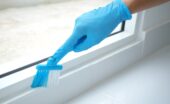DIY Tips To Patch and Repair a Hole in Drywall Safely
Written by SayBuild-admin // September 19, 2025 // Home Improvement // Comments Off on DIY Tips To Patch and Repair a Hole in Drywall Safely

Whether you’re hanging pictures, moving furniture, or working on renovations, you or your team may have bumped into the drywall and left a wide hole. Luckily, these types of repairs are simple for homeowners and require minimal tools for a clean installation. Follow these DIY tips to help you patch and repair a hole in your drywall safely by following these DIY tips!
Assess the Size and Severity of the Damage
Start by examining the hole carefully, as small nail holes require different treatment than larger gashes or punctures. To determine the severity, measure the diameter, and check if the surrounding drywall feels solid. Multiple holes clustered together or cracks extending beyond the immediate area may be a sign that your home needs professional drywall repair, so be mindful of any extreme damage within the structure.
Gather the Right Tools and Materials
For small holes, typically under one inch, you’ll need spackling paste, a putty knife, and sandpaper. Larger holes, on the other hand, require a drywall patch kit, joint compound, mesh tape, and primer. When you head down to the hardware store to pick up your supplies, always invest in safety glasses and work gloves to protect yourself from dust and sharp edges.
Clean the Area Thoroughly
Before installing anything on the surface, remove loose drywall pieces and debris from around the hole. Using a utility knife to trim any jagged edges, create clean, straight lines so that your patch adheres properly and creates a smooth finish. This step will allow you to patch and repair a hole in your drywall safely without worrying about any rubble or dirt after installation.
Apply the Appropriate Patch Method
For holes smaller than a quarter, apply spackling compound directly with a putty knife and slightly overfill the hole. For larger holes, place a self-adhesive mesh patch over the area, then apply joint compound in thin, even coats using a 6-inch drywall knife. Remove any excess from the wall before letting it dry on the surface.
Allow Proper Drying Time Between Coats
Once the patch feels secure, let each layer dry completely. This drying typically lasts for 24 hours for joint compound and 2-4 hours for spackling paste. If needed, apply multiple thin coats rather than one thick application to avoid cracking after the repair dries.
Sand It Smooth and Check Your Work
Once completely dry, sand the patched area with fine-grit sandpaper until it’s flush with the surrounding wall, and run your hand over the surface to detect any imperfections. Apply a coat of primer to prevent the patch from showing through, and use a small roller or brush to blend the paint with the existing wall color.
While these DIY tips work well for minor damage, some situations require professional expertise. If you discover extensive water damage, structural issues, or multiple large holes throughout your home, contact a qualified contractor for assistance. This way, you’ll protect your home from further damage and complete your renovations with ease.
Image Credentials: By o_lypa, 616513418








 If you want to contribute tutorials, news or other money-related stuff:
If you want to contribute tutorials, news or other money-related stuff:  Share our home building library with your facebook friends:
Share our home building library with your facebook friends:  Do you have any ideas or suggestions you would like to make?
Do you have any ideas or suggestions you would like to make?  If you like what we do, please subscribe to our
If you like what we do, please subscribe to our  All content Copyright © 2012 SayBuild. Part of nBuy Home Management Network.
All content Copyright © 2012 SayBuild. Part of nBuy Home Management Network.